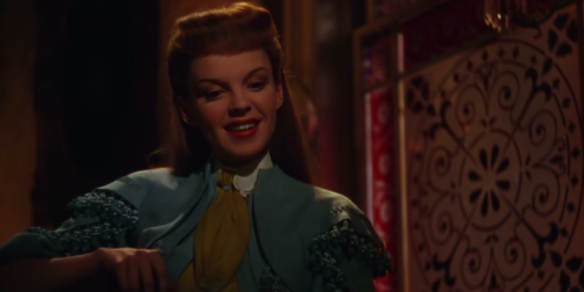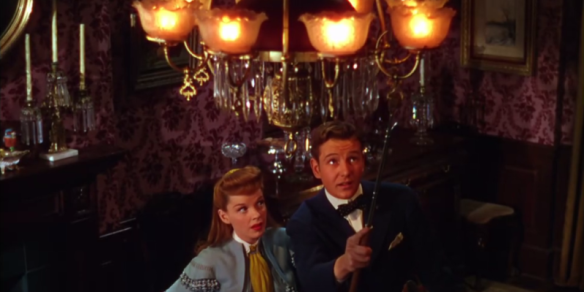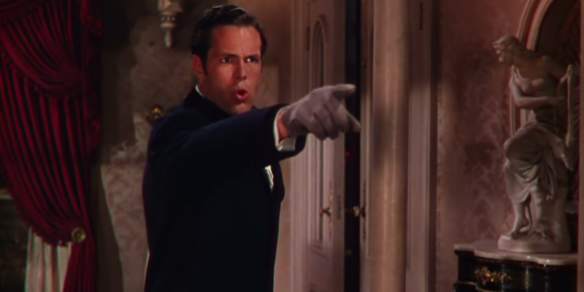The Smith family all love living in St. Louis, Missouri in 1903, and deal with regular turn-of-the-century troubles such as courting a man over the telephone, crushing on the boy next door and perfecting the latest batch of ketchup. However, their lawyer father has agreed to take a job in New York, starting just after Christmas, and plans to uproot the family from their comfortable and idyllic lives in favour of heading off to the big city.

Meet Me in St. Louis is the Movie of the Month over at the LAMB. You can listen to the podcast episode we recorded on it here. This was my first time viewing the film, and given it won the December MOTM, traditionally a slot reserved for holiday films, I was expecting something far more festive than I actually watched. Not to say that this isn’t a Christmas film, but it’s only really the final quarter of the story that takes place in December, and just as much – if not more – of the action takes place in summer and around Halloween, but no bother, it won the poll and was discussed on the show. Be warned, there are some spoilers in this review, but I doubt they’d affect your enjoyment of the film.

I’ve never been a huge musical fan. I like some, sure, but for the most part they’re generally too sweet, saccharine and meandering for my liking, especially The Sound of Music. The same can be said for the majority of Meet Me in St. Louis, given it pays far more attention to whether there’s an upcoming opportunity to burst forth into song than to an actual driving narrative, and the characters are mostly just so darn golly gee willikers chipper all the time, but there are a few moments peppered throughout that rose Meet Me in St. Louis above many of the other classic musicals from the same era.

First up there are some genuinely great songs here, with the Trolley Song being the best of the bunch. Sure it falls into the typical musical trap of starting out as an ensemble piece with everyone aboard a moving trolley singing cheerily until the star of the show, Judy Garland, starts singing, at which point everyone gathers around to listen to her instead of taking part themselves, but it remains a catchy tune regardless. This is also the film that presented the world with Have Yourself A Merry Little Christmas, so credit must be given there too, and the opening number of Meet Me in St Louis is trifling yet fun. I’m not a huge fan of The Boy Next Door, as I find the lyrics very predictable, and the party performance of Skip to My Lou felt entirely like a waste of time, but not every song in every musical is going to be a winner.

Secondly, the film looks amazing. The colours are so vibrant that they really pop on screen, even if what it is that’s coloured is in itself ghastly to look at, namely the fashions. Up until the final dance sequence practically all of the costumes are downright horrific, especially the dresses warn by Garland and Lucille Bremer as Esther and her older sister Rose. There are too many frills and layers, an abundance of detailing no-one asked for, and in colours that displease the eye. I enjoyed the hats worn by Grandpa Smith (Harry Davenport), particularly the green and white spiral number he is first seen in, and I was disappointed he wasn’t wearing a different and increasingly ridiculous hat in each scene, but there we go.

There’s a scene early on in which Esther is attempting to attract the attention of the boy next door, John Truett (Tom Drake), and keeps him after a party by requesting he assist her in turning down all the lights in their house (bear in mind this takes place in 1903, when such a task required a long stick to turn a hoop at the base of each bulb fixing). The scene is sweet, but what was more impressive was the technical achievement in lighting and staging the sequence, which is all one long shot, and was remarkably well executed for the time.

Some elements puzzled me, such as the Halloween sequence, wherein this respectable, upstanding portion of town is transformed into a children’s version of The Warriors, with the local kids building a giant fire in the middle of the road, tossing into it whatever spare wooden gear they can lay their be-costumed mitts upon, before going door to door throwing flour in people’s faces and yelling “I hate you!”. It’s clear this isn’t an unknown activity to the adults, as Grandpa advises young Tootie (Margaret O’Brien) to add water to the flour to make it more irksome for the victim to wash it off later, which begs the question as to why any self-respecting adult would open their door on October 31st, knowing an impending flouring was in stock.

That being said the Halloween segment was great, particularly Tootie heading off to flour the scariest house in town, which was shot very much like a horror film. On the subject of Tootie, she’s one of the best characters in the film, which is very unusual for me to say about a child. Tootie is precocious, as expected, but also delightfully morbid, having given her dolls up to four fatal diseases apiece, and she’s always concerned they won’t make it through the night. Esther is also a good character, someone who always look for the best in the plights of others, but who becomes excruciatingly self-indulgent and melodramatic when the slightest annoyance crosses her own path, such as when John can’t obtain his tuxedo for the Christmas dance, to which Esther’s immediate reaction is to contemplate suicide. I’m also shocked that her outcry of “What about me, and my life?!” hasn’t become more of a meme or regularly utilised GIF, as I can think of many occasions when it’d be useful online.

Tootie and Esther aren’t my favourite characters though, no, that honour goes to Warren Sheffield (Robert Sully), the long distance potential partner of Rose. Warren is a buffoon who only appears in three scenes but makes the most out of them all. Before watching this I was informed that if I didn’t cry during Garland’s rendition of Have Yourself A Merry Little Christmas then I didn’t have a soul, so I was very surprised to find that whilst I didn’t cry then, I was reduced to a fit of tear-inducing laughter when, during the climactic Christmas scene, Warren bursts into the family home and demands Rose marry him, leaving with the angriest, most direct line reading of “I LOVE YOU, MERRY CHRISTMAS!” ever committed to film. When the Smith father Alonzo (Leon Ames, also a delight) responds with “Anna, who is that boy?” I just about had to pause the film and regain my composure before going back and watching the scene twice more.

Meet Me in St. Louis is an intentionally dated film that revels in the twee, conservative nature of the past, with beliefs that nice girls don’t let boys kiss them until after they’re engaged, women shouldn’t marry men who propose to them over an invention, and where someone can sincerely use the sentence “That Welsh rarebit was ginger peachy” without anyone batting an eyelid. When viewed through a modern mindset some elements are aggravating – the father deciding to move states without even consulting anyone else in the family, including his wife – and elsewhere just plain confusing, as I’m still unsure what it means to be someone’s “tootsie-whoopsie,” but regardless, I enjoyed this musical a great deal more than I expected to. I can’t guarantee it’ll appeal to others who dislike musicals as much as I normally do, but it might be worth a shot.
Choose Film 8/10

There are definitely parts that work very well for “Meet me in St. Louis”. Tootie’s Halloween was my favorite, but I have completely forgotten that Christmas scene. I should see this movie again, but I also remembered it as being terribly sweet and endorsing sentiments that we are fortunately long past.
I am a bit surprised you liked it this much.
I’m surprised I liked it as much as I did too!